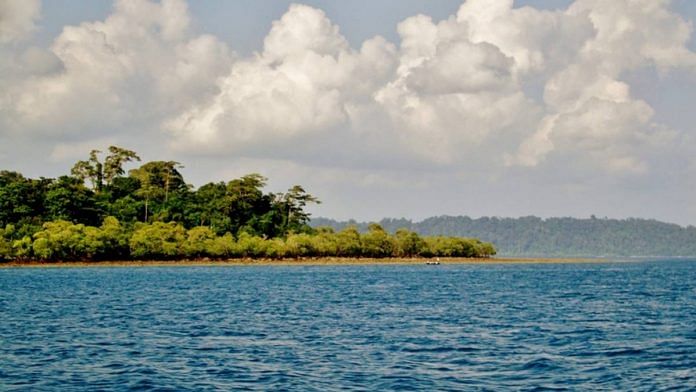New Delhi: The central government-appointed expert appraisal committee (EAC), tasked with vetting projects before granting them environmental clearance, has identified several gaps in the NITI Aayog’s plan to develop the remote Great Nicobar Island. The panel has sought more details, so it can take an “informed decision” on the matter.
The NITI Aayog has proposed creating a Rs 72,000 crore International Container Transshipment Terminal, airport, thermal power plant, and township on the largely uninhabited island, which is rich in biodiversity.
In line with environmental clearance norms, an environmental impact assessment (EIA) report on the project was submitted to the committee earlier this year. The EIA is a process to evaluate the impacts of a project and its construction on the local ecology.
In a meeting held over two days, 24 and 25 May, the committee observed that the EIA report excluded assessment plans it had specifically sought earlier, such as a risk assessment for oil spills and rehabilitation and mitigation plans for several species impacted by the project.
The Great Nicobar Island is known to have over 1,700 species of animals, and is one of the most biodiverse parts of the country, with large swathes of natural, dense forest.
“In response to EAC’s request for a saltwater crocodile management plan, no plan has been submitted except the assurance of following an action plan for mitigation of human-crocodile conflict,” said the minutes of the meeting, which were made public last week.
The committee also recognised that the transshipment port is “likely to disturb” the nesting habits of the critically endangered giant leatherback turtle, contrary to claims in the EIA report that the turtles “can enter to the nesting site without any hinderance (sic)”.
The giant leatherback turtle is a globally endangered species with few nesting sites across the world. One of them is the Galathea Bay in the Great Nicobar Island, which is also the selected site for the transshipment port worth thousands of crores. Environmentalists have said that construction of the port will endanger the turtles further, and cause irreversible damage to the island’s ecology.
The committee did not, however, suggest that the port be shifted, citing defence activities there. It asked the Ministry of Environment, Forest and Climate Change to consider other channels to protect the current nesting sites, and proposed three alternative nesting sites for the turtles as well as megapode birds. The Great Nicobar Island is also a nesting place for these megapodes, who will be affected by the project.
ThePrint reached a Niti Aayog spokesperson Friday over email for comment. The copy will be updated once a response is received.
Also read: Monsoon has turned normal, IMD says. But it really hasn’t if you see regional variations
‘No justification’ for gaps
The committee has asked for a complete overhaul to parts of the plan submitted in the EIA.
The construction of a township, airport, and power plant “will obstruct the forest to sea shore to forest” movement of several animals, and there is no provision for any such corridor in the NITI Aayog’s plan, the committee noted, according to the minutes of the May meeting.
“Therefore, there is a need to revise the master plan layout keeping natural forest corridor” every three kilometers, with a width of 300-500 metres, the committee said.
The committee further noted that the NITI Aayog “has not submitted any mangrove conservation plan/coral conservation plan which normally forms the part of EIA/Environmental Management Plan”.
“No justification has been given for not including mangrove conservation plan, including the plan for compensatory planting in lieu of loss of mangrove cover. Similarly, coral conservation plan has not been included,” it added.
Around 12 to 20 hectares of mangrove cover will be lost, over 8 lakh trees cut, and more than a square kilometer of coral destroyed due to the project, according to the project plan.
The Andaman and Nicobar Islands are also prone to natural disasters such as earthquakes, and the committee noted that the plan made no mention of this.
“Evacuation plans for natural disaster needs to (be) spelt out clearly and in detail since this area is prone to tsunami, frequent earthquakes and cyclone etc,” said the committee.
It also demanded that the Wildlife Institute of India submit “a detailed road map” of costs to monitor the movements of the giant leatherback turtles, habitat restoration, and nest protection for the next 10 years.
The questions posed by the EAC find echo in concerns raised by environmental experts against the NITI Aayog plan. Earlier too, several environmental organisations, researchers, and citizens had made written submissions to the Andaman and Nicobar Administration Pollution Control Committee, asking for the EIA report to be revised.
Avli Verma, a researcher with the Manthan Adhyayan Kendra, an environmental research organisation, said the committee’s observations pointed out the many deficiencies of the EIA.
“The committee has pointed to a diverse range of issues that show how deficient the EIA was. It shows that there was very little thought given to the impacts of this project. The question is, why is this quality of EIA being entertained? And should it be entertained?” she asked, while speaking to ThePrint.
This report has been updated to correct a typo
(Edited by Poulomi Banerjee)
Also read: ‘Unscientific,’ says govt as Yale-Columbia environment index ranks India last among 180 nations






